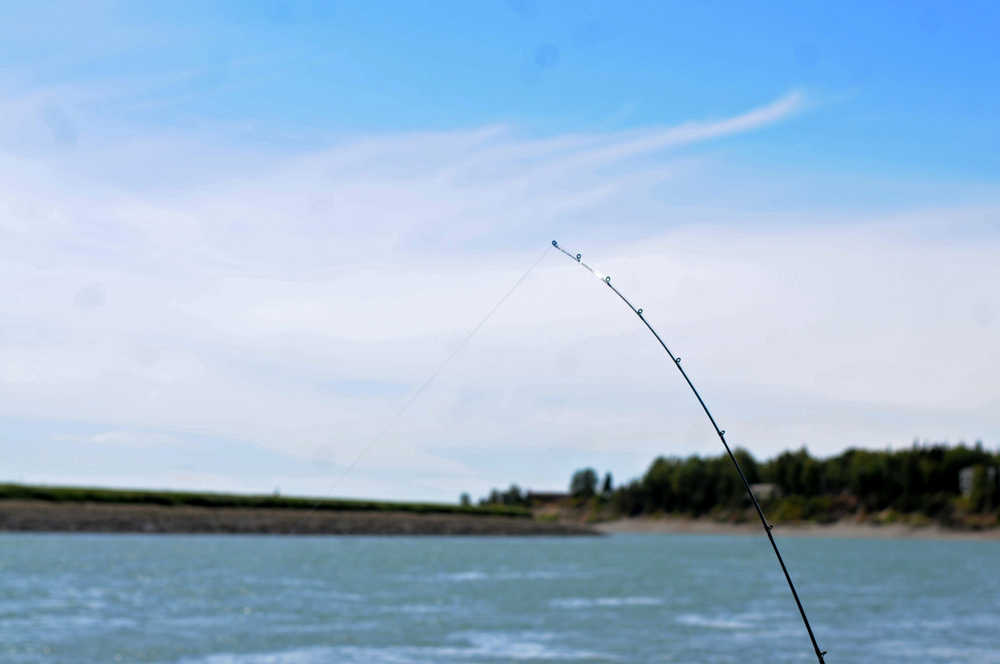Though the king salmon season is over, the fishing season for other species is just getting started on the Kenai River.
In less than an hour Wednesday afternoon at Cunningham Park in Kenai, anglers had landed a Dolly Varden, two silvers and hooked into a red salmon. Usually at this time of the year, fishermen begin to switch their targets from sockeye and kings to silver salmon, which make their way up the river from August through October.
Some anglers have reported catching coho as far up the river as Soldotna, but overall, sportfishermen should temper their expectations for a coho run — it might be later than usual, the way it was last year, said Jason Pawluk, the acting area management biologist for the Division of Sportfish in Soldotna.
Coho are very sensitive to water temperature, which could impact when they choose to enter the river. When the cohos do start arriving in big numbers, fishermen will usually anchor in boats fairly close to the bank and fish for them from there.
“Last year, based on logbook data, we really did not see a push into the river until Aug. 20,” Pawluk said. “Coho are very notorious for trying to avoid warm water.”
The big push into the river this week will likely be pink salmon. Pinks return in massive numbers on even years in Upper Cook Inlet, possibly in the millions, though Fish and Game does not enumerate them. Fishermen will likely be wading through a crowd of pinks on the Kenai River for a little while, Pawluk said.
While pinks are not as desirable a fish for food — the meat tends to turn faster — they can be fun to fish for. The best place to fish for them would be near the mouth, where they come in and are chrome, before they turn to spawning colors. Pink salmon will bite at virtually anything dropped in front of them, Pawluk said.
“Probably the most successful method is spinners,” he said. “(They’ll go for) spoons, and they go after plugs pretty good, too. They’ll also go for eggs.”
With almost a month left, the Kenai River sockeye are about 110,000 fish shy of reaching the lower end of the inriver optimum escapement goal.
That’s after frequent commercial fishing openings, the month-long Kenai River personal use dipnet fishery and the peak of the tourist season on the inriver rod and reel fishery. Approximately 990,845 fish have passed the Alaska Department of Fish and Game’s sonar at river mile 19 as of Tuesday, about 21,000 fish ahead of last year’s count on that date, according to Fish and Game data.
And yet, fishing success in all quarters has remained low. Dipnetters reported little luck throughout the month, rod and reel fishermen on the Kenai River consistently report fishing as slow and commercial fishing harvest on sockeye has been less than originally forecast.
Pawluk said he would expect there to be small bumps in the number of sockeye salmon entering the Kenai River, and opportunities remain for rod and reel fishermen, but in general things are slowing down.
As they do, anglers will likely look more to resident species like rainbow trout and Dolly Varden. Some Dolly Varden will be coming in from the ocean, but others live in the Kenai River system year-round, Pawluk said. One popular method is to use beads when fishing for them, he said. The bag limit for Dolly Varden is one per day with one in possession in flowing waters of the flowing waters of the Kenai River; on the upper river, it must be less than 16 inches, but on the lower river, it must be less than 18 inches long. In lakes and ponds, the bag limit is two per day with two in possession, and only one fish may be 20 inches or longer. In waters outside the Kenai River drainage, the limit for flowing waters is two per day with two in possession in flowing waters and five per day with five in possession for lakes and ponds.
One more week remains on the Kasilof River personal use dipnet fishery, but the fish tend to come in more slowly there than on the Kenai River — less than 5,000 fish usually pass the sonar on the Kasilof River per day.
Those who participated in the personal use fisheries should turn in their permits with all fish recorded by Aug. 15 to the Fish and Game. Personal use permits can be turned in in person at the one of the offices, by mail or online through the Fish and Game website. Those who do not return the permits may be subject to a $200 fine and loss of personal use fishing privileges.
In Homer, the jackpot halibut derby has about five weeks left in its run. The current leader, Gayle Maggio of Miles City, Montana, has sat atop the pack for nigh on a month now with a 167.2-pound halibut she caught July 8. Five tagged fish were caught in June and two were caught in July.
Seward’s annual Silver Salmon Derby begins Aug. 13 and runs through Aug. 21. The angler with the heaviest fish will take home $10,000, while the angler who reels in a tagged fish could win anything from $1,000 to a new truck. Tickets go on sale on the night of Aug. 12.
Reach Elizabeth Earl at elizabeth.earl@peninsulaclarion.com.

